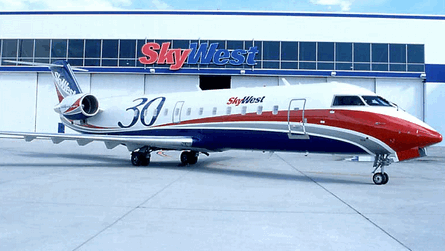Operators of Bombardier CRJ100/200s have begun to install--and sing the praises of--a redesigned flap system for the regional jets that is expected to mitigate the problem of flap failures linked to cold weather operations.
In the three months since implementation, approximately 15% of the CRJ100/200 fleet has already undergone the enhancement, says Bombardier. "We are commercially supporting our operators with the optional flap actuator upgrades of their CRJ100/200 fleet which calls for seal replacement kits to be installed on wing."
The largest operator of the type in the world SkyWest says it has already begun installing the permanent modifications "and we anticipate little to no operational interruptions for installation". The firm expects all the work to be completed before the winter season, which begins in November 2009.
 |
|---|
© SkyWest |
Pinnacle Airlines, which operates about 124 CRJ200s, is also championing the new fix. Company president and CEO Phil Trenary says the actuator is giving the carrier more confidence "than in anything I've seen since we started operating the aircraft".
He adds: "It will actually have a positive impact on the performance. Our folks in maintenance have done a good job on that and we expect to have approximately half the fleet converted by 1 January and when you have half the fleet that gives us some options as far as trying to keep the aircraft out of the colder weather."
The newly certificated system is Bombardier's long-term fix to a cold weather-related stuck flap problem that last year prompted Canadian and US regulators to issue airworthiness directives. Moisture ingress was considered the primary contributing factor. However, it later became apparent that oil migration in the actuator also played a role.
Among other measures, the directives called for operators to clean and lubricate the flexible shafts and install metallic seals in the flexible drive-shafts. In cases of damage, a low-temperature torque check on the actuator had to be performed prior to further flight.
SkyWest knew it had a flap problem on the aircraft before the FAA came out with its mandates. "That caused us to be ahead of the curve rather than behind. We weren't necessarily in a position where we were waiting for a recommended fix," says SkyWest VP of finance and treasurer Michael Kraupp.
"Our guys moved ahead with some things and then obviously once the FAA mandate came out on how to fix it we made sure that our entire fleet was in correlation with all the recommended changes that were there."
Yet in January 2008 SkyWest revealed it was experiencing "some challenges and difficulty" in implementing the flap fix that was then available.
Working with US manufacturer Eaton, Bombardier developed what it now considers a permanent fix to the issue. The company completed testing of a new seal and achieved certification. "In the spirit of continuous improvement, we are always looking for ways to improve our products and in this case, to enhance the reliability of the flap system," says the Canadian airframer.
Source: Air Transport Intelligence news























